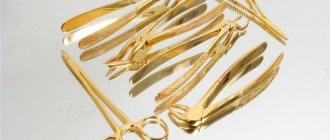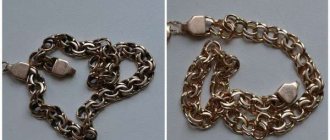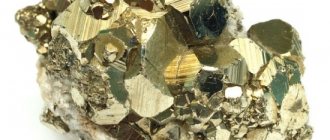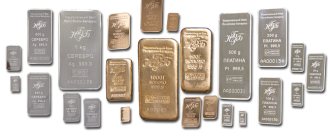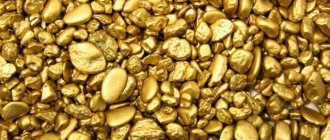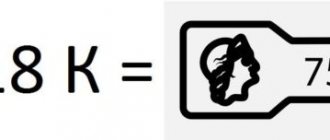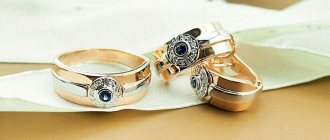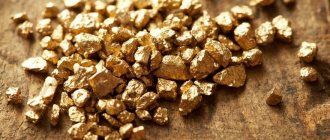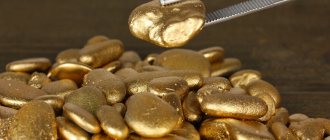Since gold is a sign of wealth, wealthy people try to use it in all areas. Everything is done in order to demonstrate your status and surprise others. It was for this purpose that edible gold, also called gold leaf, appeared.
This type of precious metal processing first appeared in China; mention of it dates back to 1700. But gold leaf was originally intended as an element of interior decoration. And only then confectioners came up with another use for gold.
Edible gold
Custom or love of luxury?
In Japan, it is customary to drink the national alcoholic drink sake with the addition of gold flakes on New Year's Eve. This symbolizes good luck and happiness in the coming year.
In sophisticated France, it is customary to add gold to champagne, which most often emphasizes the noble origin of the wine brand and its value.
In England, golden confetti is sold for special occasions and is also added to sparkling wines. But this has more to do with the moment itself than with the quality of the drink into which the confetti is added.
All over the world, sweets in gold wrappers and “golden” pies are popular, which are also eaten together with gold film. How did the idea of eating gold come about?

History of appearance
It began to be used as a food product only in 2009, when it appeared on the shelves of elite confectionery shops in London. The very tradition of using gold for food dates back to the experiments of medieval alchemists in China and Arab countries, who later spread the results of research on the effects of gold on the human body throughout medieval Europe. However, already in the 16th century, the first golden drinks appeared, symbolizing luxury and uniqueness.
Gold today
Today, edible gold is used throughout the world. Despite all the efforts of chefs and confectionery companies, chocolate factories and restaurants in the largest European countries, the USA and Great Britain, India is the leader in the consumption of gold in food. This is more related to traditions, but statistics indicate that Indians consume up to 12 tons of precious metal annually.
Edible gold is used for cakes, pizzas and burgers as decoration. The most famous are chocolate products in edible wrappers and alcoholic drinks with metal dust. So, for about ten years now, a hypoallergenic metal specially developed for culinary purposes has been actively used in cooking around the world.
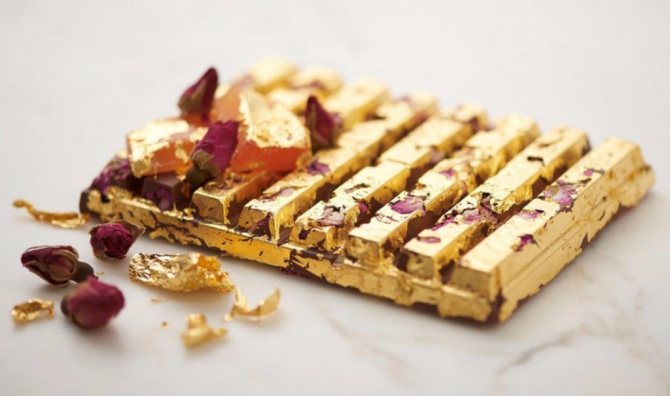
Edible gold
Gold, suitable for consumption, has a simple composition: 96% pure gold and only 4% silver. In the food industry it is designated as dye E-175.
The first mention of gold was found among the ancient Egyptians. They considered gold sacred, and therefore used it not only to decorate tombs and sarcophagi, but also consumed it with food, thereby, in their opinion, getting closer to the deities.
The 13th century Italian merchant and traveler Marco Polo mentions mixing food with gold in the Far East in his notes "Million".
In Europe, edible gold appeared in the Middle Ages. For example, in 1561 in Venice, at the wedding of the Prince of Bisignan, bread and oysters were served in gold leaf. There, the nuns of the Santa Maria Celesta orphanage covered traditional Venetian cookies with gold. The consumption of gold in food became widespread in the 16th century, and the city council of Venice limited its consumption: only two dishes decorated with the precious metal were allowed to be served at festive feasts.
In England during the time of Elizabeth the First, it was customary to decorate fruits with leaves of gold leaf, and sprinkle grapes with gold powder.
The use of edible gold has also spread to medicine. Doctors in Italy and England decorated their medicines with it to distract patients from the bitter taste. Since then, the saying “gild the pill” has emerged.
Today, gold also occupies a leading position in decorating dishes and drinks. It can be presented not only in the form of thin leaves, but also in the form of powder, flakes and granules. The food additive E-175 has neither taste nor odor. In moderate quantities, it has a beneficial effect on the human body and health. For example, gold helps normalize metabolism and improves liver and stomach function. Silver contained in the food additive E-175 has bactericidal properties. In this regard, edible gold is a hypoallergenic food coloring.
In the modern world, a separate use of edible gold in cosmetology has appeared - chrysotherapy.
Scientific studies have shown that gold masks activate basal skin cells, retain moisture, preserve collagen and inhibit the decomposition of elastin, which helps reduce wrinkles and, accordingly, rejuvenate the skin.
Given the wide range of uses of gold, a mechanized method for its production was developed. In the old days, gold was hammered by a master with a good eye, since it was necessary to hit with a hammer in a certain order and place. Now this is done by special machines, which has increased the production of gold sheets. The resulting sheets are cut and placed in a tissue paper book measuring 80 x 80 mm, or in rare cases, for the sake of economy, in a book measuring 91.5 x 91.5 mm. A book can have from 5 to 60 sheets.
Unfortunately, some sellers of online stores, under the guise of edible gold, sell imitation gold leaf - potal, which can lead to severe poisoning, because... potal is an alloy of copper and zinc. How to distinguish real edible gold E-175 from a fake? If you are a buyer, you must be provided with a certificate upon purchase, which will indicate the composition. Also, gold sheets of the food additive E-175 have a standard size of 80 x 80 mm or 91.5 x 91.5 mm. If you are offered to purchase gold sheets of a larger size, for example 140 x 140 mm or 160 x 160 mm, there is no doubt that this is a fake. The cost of edible gold also plays a significant role, which cannot be lower than the established value on the international currency exchange. If you are a consumer and decide to try something with edible gold, then feel free to ask the confectioners for certificates. You can also recognize a fake visually. Sheets of edible gold or flakes are very thin, unlike gold leaf, if you rub a small piece of gold between your fingers, then nothing will remain of it, but if it turns out to be a fake in the form of gold leaf, then you will immediately feel the thin foil, when rubbed, oxidation will occur, i.e. e. the gold leaf will darken, becoming either black or greenish. Edible gold has no taste, but if you feel a metallic taste in your mouth, it means that fake gold is used instead of edible gold - gold leaf.
Impact on the body
Edible gold has long been recognized as not only a metal that is harmless to the body, but also has a positive effect. In ancient times, gold was prescribed to treat heart attacks, and today it has been scientifically proven that taking certain doses of this metal improves a person’s condition with nervous disorders and diseases of the respiratory system. In addition, gold ions improve the body’s hormonal levels and overall human health, strengthening the immune system.
If you're interested in creating your own gold-infused culinary masterpiece, but don't know what edible gold is called, you might want to learn a little about the standardized product used as a dietary supplement. The so-called E-175, formed into the thinnest light gold sheets, powder or flakes, can be purchased at any specialty store. This additive is absolutely safe for people suffering from any type of allergic reactions, so you can safely start working with it in any type of dish. The only question is whether you really want to spend money on luxury that has no taste or smell. Many representatives of elite culinary chefs have made their choice.
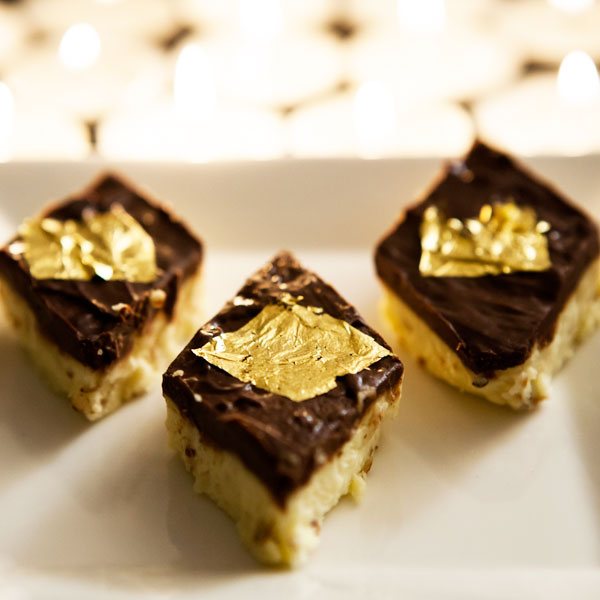
You can eat gold
In recent international rankings of the most expensive gastronomic products in the world, edible gold has confidently taken first place. This product is usually presented in the form of very, very thin foil or tiny granules. This is ordinary gold, but eating a bar of real precious metal is very expensive, not very tasty, and generally hardly possible.
But gold, which is edible, is produced by the Excenevex factory. So to speak, according to GOST, this gold must have 24 carats. Edible gold has been successfully used in cooking for quite a long time and continues to be in great demand, although gold has recently risen significantly in price. Elite confectioners and confectionery factories apply the thinnest layers of gold foil to their products (most often on chocolate bars, candies, and, of course, on cakes).
Strange as it may sound, gold can also be seen in elite drinks containing alcohol.
In addition to adding originality and beauty to a dish, edible gold has other functions. For example, gold has long been famous for its hypoallergenic effect. Remember, just recently it was fashionable to have gold teeth (beautiful and useful). Moreover, gold, although it is a metal, does not have a negative effect on digestion.
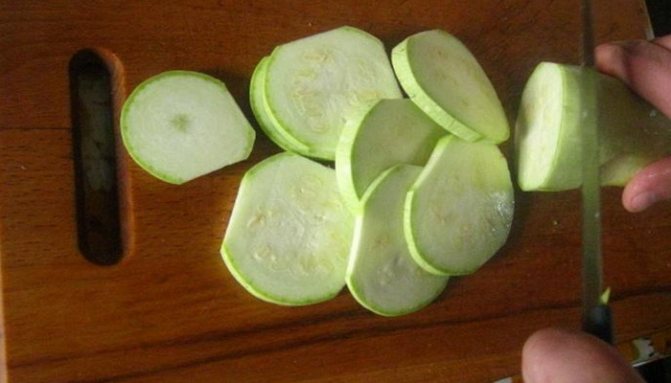
Recently, it has also become known about the use of such gold in medicine as a food additive (E175) - if such an additive is in the product, then the high cost of the product should no longer be surprising. Scientists have already come up with a name to designate treatment with drugs that contain edible gold - “gold therapy”.
A set of 25 sheets of edible gold foil will cost $75. Manufacturers' recommendations are as follows: gold is an additive for liquid homogeneous food, also for solid food, and attachment to the dish occurs with the help of sunflower oil mixed with sugar and liquid.
For a kilogram of such gold you will have to pay 30-110 thousand dollars (the price varies depending on the shape and quality).
India is the largest consumer of edible gold today.
Many world-famous chefs often use this gold in the preparation of their dishes: Gualtero Marchesi, Christophe Marguin, Philippe Bernachon make edible gold as an ingredient in their chocolates and main courses (in particular meat).
Modern research
In modern medicine, a solution based on gold ions and demineralized water is extremely popular. It is called colloidal and is used in various fields of medicine.
In the 20th century, the German bacteriologist Robert Koch made a number of discoveries about the unique properties of gold and its effect on various diseases of a bacterial nature. The scientist received the Nobel Prize for his research into the inhibitory effect of gold on the tuberculosis bacillus. Thanks to these studies, the possibility of treating other similar respiratory diseases is now open.
Gold strengthens the heart muscle and the walls of blood vessels, which has a positive effect on the entire cardiovascular system.
The most surprising and most popular trend in medicine today is gold dietary supplements and their use in the treatment of mental disorders. By improving blood circulation in the brain and peripheral nervous system, the speed of thinking increases, by relaxing muscles and nerves, tension is relieved and depression is treated. Modern research considers gold as a metal that can fight drug and alcohol addiction.
It is believed that gold destroys cancer cells, having a gentle effect on the body.
In elite cooking
On the menus of the most expensive restaurants in the world in France, the USA and Turkey you will find several different types of dishes costing up to several tens of thousands of dollars. In high-end cooking, edible gold is used in the form of extremely thin sheets of 24-karat gold. In addition to sheets, gold shavings and granules are used. Each dish is unique in its own way and offers a special luxury for lovers of a spectacular gastronomic experience.

Those who are ready to do anything for new taste experiences (although here the appearance of the dish is more likely to drive the appetite) will have to spend several million dollars on them. An interesting example of “golden cooking” is the so-called 24 Carrot Cake, made in the form of a gold bar. The chefs' imagination doesn't stop there: there are lollipops with golden crumbs, ice cream and a variety of drinks in the world.
Gold leaf and areas of application
Gold leaf is a type of metal processing in which it is rolled into a thin sheet 100 nanometers thick. This is facilitated by such physical properties of gold as:
- Malleability, thanks to which the precious metal can be rolled into a thin sheet or wire and at the same time maintaining the integrity of the element.
- Plasticity of metal.
- Lack of interaction with the environment.
- Softness of metal. Gold is a soft substance; in its pure form, a gold product can be crushed, scratched even with a fingernail, or deformed.
Gold leaf has a formula or manufacturing sequence. The essence of the technique is that first a large block of gold is cast. The block is then cut into smaller pieces in the shape of cubes. They are placed on a precious metal anvil and beaten with a hammer until the bars become flat. For the operation to be successful and the block to turn into a plate, you need to apply more than two hundred blows with a hammer.
Of course, the whole procedure is mechanized, since the hammer must be struck in a certain order and place. This is necessary in order to break the block evenly and make its thickness very thin and uniform. Of course, in the old days this was done by an employee with a good eye. Manufacturers are now gradually moving from machines and conveyors to robots that transfer plates.
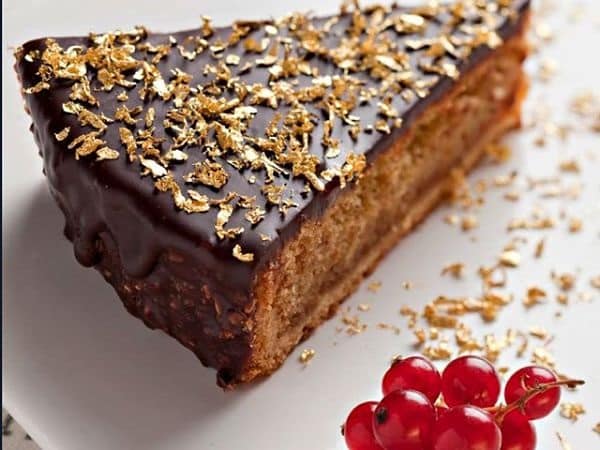
Gold in food
The resulting plates are placed in a book, which can contain up to three hundred pages. The plates must be free of cracks, scratches or breaks. The manufacturing process itself consists of thirty operations, and each manufacturer keeps it secret.
Among the areas of use of gold leaf are:
- Decorating items. Applying a layer of precious metal to objects is called gilding. This is the simplest and oldest method of gilding products. Today, gold plating is used using electrolysis and galvanization. The technology is considered more durable than the use of plates, which can peel off over time and quickly lose their visual appeal. Therefore, precious metal leaf is now used less often in the interior.
- Take with food. Edible gold is used as an additive called E175. The additive contains gold leaf with a metal content of 96%, and 4% of the product consists of silver.
